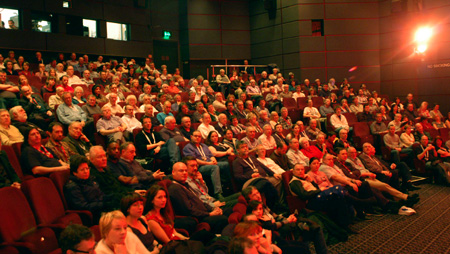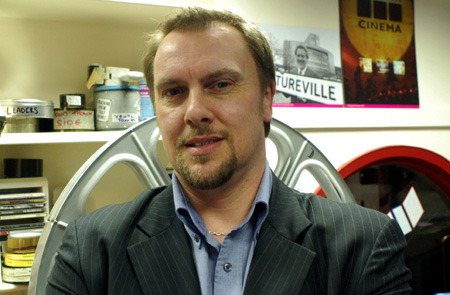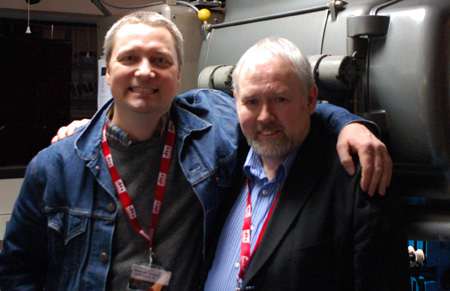|
| | Cinerama Showcase
The National Media Museum celebrates a piece of film history next month. | Read more at
in70mm.com
The 70mm Newsletter
| | Written by: Jim Barg, Rochester, New York | Date: 05.03.2010 |  The "Widescreeners", the best audience in the world. Image by Thomas Hauerslev The "Widescreeners", the best audience in the world. Image by Thomas Hauerslev
There were no stars. No story. Just three panels of stunning images
projected in full colour on a curved screen backed by seven channels of
sound placed around the auditorium. A far cry from the black and white
images and monophonic sound moviegoers were used to.
“This is Cinerama!” Lowell Thomas, the man best known for bringing Lawrence
of Arabia to popular attention, told the audience as the images shifted from
staid black and white to dazzling color.
After years of filming productions in a squarish projection format known
informally as the 'Academy' ratio, an event on September 30, 1952.in New
York caught the eye of movie studios worldwide.
There had been large-format presentations before, but never with any
success. As the use of sound became standard in the late 1920s, Hollywood
studios such as 20th Century Fox and Metro-Goldwyn-Mayer experimented with
70mm film, as the results were markedly better than the standard 35mm film.
But the economic reality of the Depression made the idea an unnecessary
luxury.
The idea of widescreen film never went away, however. Twenty years later,
studios had seen their attendance numbers slump due to the onslaught of
television. The Paramount Decree anti-trust decision by the US Supreme Court
in 1948 forced studios to sell off their ownership of movie palaces, where
films could play for years and make massive profit. Something had to be
done.
Fred Waller was an American inventor who patented the use of film cameras
for gunnery training
for American soldiers during World War II. After the war, with the help of
Hollywood producer Merian C. Cooper (the original "King Kong"),
Waller perfected the interlocked three camera setup (compared to the single
camera used for standard projection), which provided a field of vision that
simulated the eye's natural curve when projected on a special louvered
screen.
|
More in 70mm reading:
Widescreen Weekend, Bradford, England
Made in Yorkshire
Internet link:
nationalmediamuseum.org.uk
tonyearnshaw.com
Jim writes (3/20/10):
After reading one of Roger Ebert's blog posts, I commented that I was
attending the Bradford event this week, along with asking how to cover a
film festival as a journalist and I got this as a response in my inbox:
"Hey, send me a piece about the *experience* of wide screen, and I'll run
it! Especially if they show Cinerama.
Cheers,
R"
I sent Mr. Ebert the link to this article, and received this as a response:
"It's perfect as it stands.
Cheers,
R"
The article is (will be) reprinted over at Mr. Ebert's blog,
rogerebert.suntimes.com. Thanks to Thomas for allowing me to reprint the
article.
| "This is Cinerama" sparked a widescreen craze, as rival studios raced to put their own cheaper spin on what became the scope format. Sixty years before the term '3-D' became a catchphrase in Hollywood, marketing departments scrambled to come up with their own 'Scope' or 'Rama' to compete with Cinerama. Such phrases as 'CinemaScope' and 'VistaVision' would blare out from posters in theatre lobbies everywhere.
Cinerama would make $9 million in its initial three-year run, an impressive sum considering the film played in only a handful of theatres across North America and Europe. Cinerama, Inc. promptly made four more travelogues through the 1950s to capitalize on the demand.
In time, the format proved too costly for theatre owners. Despite success with the travelogues and MGM agreeing to finance three films, Cinerama, as originally envisioned, died in 1962. Only 150 theatres worldwide had been equipped for the process, and half of their profits were swallowed up by operating costs.
Large-format presentations became popular again after the success of Star Wars in 1977, as films shot in 35mm film, blown up to higher-quality 70mm, became standard for many of the 1970s and 1980s blockbusters. Cinerama, though, seemed destined to be a footnote in film history.
By 1993, the blow-up era had also ended due to the advent of digital sound. Standard 35mm film has four channels of sound available on its soundtrack, 70mm has six. The advent of digital sound meant that you could recreate the higher sonic quality of 70mm in an easier and more affordable way than having to install the projectors and screens needed for 70mm presentations. Theatre exhibitors refit many 70mm-capable screens to 35mm as a result.
Despite reissues of classic epics ("Lawrence of Arabia", "Spartacus", "My Fair Lady") through the early 1990s, the abandonment of 70mm meant that to see those films as intended, one had to travel to large screen venues in major cities like London, New York and Los Angeles.
|
31.03.2010
Dear Jim
Just to say thank you for a marvellous write up on the Widescreen
Weekend - most informative and great for those of us who unfortunately
couldn't be there this year!
Best wishes
Brian Guckian
|  Tony Earnshaw, Artistic Director of the Bradford Film Festival. Image by Thomas Hauerslev Tony Earnshaw, Artistic Director of the Bradford Film Festival. Image by Thomas Hauerslev
Enter the Pictureville Cinema in Bradford, England, part of the National Media Museum.
The NMM spent four years and countless volunteer hours building a 1360-piece louvered screen for Cinerama screenings. The search for pieces reached far and wide, from Helsinki to Baltimore. The museum held a copy of Cinerama in their archives, and held a special screening to premiere the new installation in June 1993.
“The idea was to be able to show film in every possible format. We had 35mm, we had 70mm, why not Cinerama?” Tony Earnshaw says. Earnshaw is the Artistic Director of the Bradford Film Festival, which will have its annual Widescreen Weekend from March 26 to 29.
It was the first time the film had been screened in any format since 1973, and its first Cinerama presentation since the early 1960s. At the time, Pictureville was the only cinema in the world equipped to show true three-strip Cinerama. Bill Lawrence, former Head of Film for the Museum and now Creative Director at the Showroom Workstation in Sheffield, recalls the screening fondly.
“I'd never seen Cinerama before. I remember when 2001 was advertised as being in Cinerama, but found out otherwise,” he says. “This was a special and unique experience.”
To celebrate the history of widescreen cinema, the NMM began what came to be known as the Widescreen Weekend in 1994. It became so successful that the NMM started the Film Festival a year later to capitalize on the Weekend's popularity.
The Weekend eventually became what Earnshaw calls 'a festival within a festival, created by cinephiles for cinephiles'.
“It has a very convention-like feel. It's not a typical film audience. We have people who make it part of their yearly calendar, part of their holiday.”
| | Thomas Hauerslev is one of those that makes it a part of his calendar. The Copenhagen resident has had a passion for 70mm film ever since a childhood screening of "The Guns of Navarone" [in 35mm CinemaScope] at the Imperial Bio in Copenhagen. He became a projectionist in Copenhagen in April 1982 and spent the next twelve years running film at various theatres across the city.
When fatherhood forced him to give up projecting, his interest in film allowed him to edit “The 70mm Newsletter” which morphed into the in70mm.com website in June 1999. The website has become a one-stop shop for 70mm history and news, and helped to popularize the Weekend worldwide. Hauerslev has even helped to program the Weekend schedule on occasion.
“It’s a very audience friendly festival. Anyone who has something to say about 70mm or Cinerama can get a microphone and say it. It’s a very unique concept of letting the audience talk. We also have a practice of letting (70mm) enthusiasts introduce each film to set the tone.” he says.
Lawrence left the NMM in 2008, but still attends the Weekend every year. “Oh, I've got a lot of good memories. One that sticks out in my mind is the creation of Cineramaracana, where we show 70mm shorts, trailers and bits of other films. One year, a gentleman came up to me and asked if we could show a 70mm reel he'd brought of (Otto Preminger's 1959 version of) "Porgy and Bess". That went over so well, we found a spot for people's submissions on Sunday mornings.”
Earnshaw's favorite memories are meeting stars and directors connected with Hollywood's past.
“It's the guests I remember most. Over the years, we've lost five or six people that we've interviewed. The key thing for me, is getting these people's memories on video and audio. Ken Annakin was a guest when we screened "The Longest Day". We had Jean Simmons, who just died last month, for a screening of "Spartacus".”
| |  Thomas Hauerslev, in70mm.com and Bill Lawrence, in70mm.com Thomas Hauerslev, in70mm.com and Bill Lawrence, in70mm.com
Hauerslev enjoys the audience reaction best. “There are many, but I think the good response and many happy smiles from people are among my favourites.”
This year's Weekend will not only show 70mm prints of modern favourites "2001" and "Die Hard", it will, as always, showcase Cinerama. Not only will "This is Cinerama" kick off the festivities proper, there will be a showing of rare travelogue Flying Clipper and a discussion about restoring a dead format for 21st century technology by Dave Strohmaier.
Strohmaier is one of the world's pre-eminent Cinerama experts, having turned
his childhood passion for film into a lifetime spent in the industry. A
freelance editor by trade, Strohmaier took eight years to craft a
documentary on the process, "Cinerama Adventure".
Buoyed by its success at festival screenings worldwide, Warner Home Video
hired him as a consultant for the company's DVD
re-master of the 1962 epic "How The West Was Won",
one of only two narrative films shot in true three-camera Cinerama.
Strohmaier has been hard at work with plans to re-master other three-camera
films, and Bradford will see the premiere of his latest effort, a digital
re-mastering of "Windjammer".
The 1958 travelogue was shot in a process called Cinemiracle, which
attempted to eliminate the visible join lines Cinerama screenings produced
when projected through three cameras. While the results may not have been
successful in 1958, Strohmaier is working to perfect the process for DVD. A
cursory look at West's DVD release will show a single image across a
widescreen frame, only betraying its three-camera origins when blue sky
comes onscreen and the join lines are faintly visible.
From his home in California, Strohmaier is adding the final touches. It's
important to note that the final result will not be as pristine as "West",
since Strohmaier is working from lower-quality duplicate negatives.
"Windjammer", he says ”is sort of a lost film with only very faded 3
panel original prints located in Australia and Bradford - they are barely
showable.” In comparison, the re-mastering of "West" used well-stored original
elements from the WB vaults.
“This will be the first time in 35-plus years that the film will be seen in
colour. Smilebox will be employed to give it a curved screen look.” he adds.
Smilebox is the process used to replicate Cinerama's curved screen for home
viewing, and as of right now it can only be seen on the high definition Blu-Ray
release of "West" and on digital screenings of Cinerama films. Standard DVD
releases show the films in typical scope format.
The future of large-format presentation seems bright. More studios are planning to release films in IMAX, which is a similar process of blowing up 35mm film to 70mm dimensions. Successful runs for "Avatar" and "The Dark Knight" have led studios to announce IMAX engagements well in advance. IMAX Corporation has publicized film releases as far ahead as the summer of 2012.
| |
The success of the Widescreen Weekend has
seen 70mm festivals pop up worldwide. Places as diverse as Karlsruhe,
Germany and Ottawa, Canada have
festivals planned for later in 2010.
“I think it's brilliant,” Lawrence says. “It's really good that this
format of films is being celebrated in other places.”
“What's the old standby? Imitation is the sincerest form of flattery.”
Earnshaw continues.
“I feel good, since 70mm is slipping through our fingers faster and
faster every day. 70mm (presentations) seem to pop up here and there.
Last year was great, as the Berlinale
Film Festival in Germany showed a long program of 70mm titles.”
Hauerslev adds.
As for Bradford's future, Earnshaw admits there is a challenge to
finding product to show, as he prefers to show films from the 1950s and
60s, rather than 70mm films from the 1970s and beyond.
“There's challenge in trying to come up with new material.” he says.
“Someone in their 80s might have a different view of what is considered
'classic' than I do. At the end of the day, we're just entertainers. We
hope to select films that will send people home happy.”
| |
The Bradford Widescreen Weekend is
scheduled for March 26th through the 29th as part of the Bradford Film
Festival. For tickets and information, please visit nationalmediamuseum.org.uk.
| | Jim Barg, the writer | |
Jim Barg is a native of Rochester, New York,
home to the George Eastman House, one of the great film archives in the
world. His interest in 70mm film can be blamed on the massive poster-sized ads
routinely published in the New York Times' entertainment section promoting
large-format presentation. Because of the rarity of 70mm presentation in
Rochester, he has seen only one film in true 70mm (a surprise viewing of "Vertigo"
in 1997), but is looking forward to attending the Bradford event for the
first time. He currently resides in London, where he is completing a
master's degree in journalism at Goldsmiths College after spending the
previous nine years working at a multiplex theatre in Rochester.
| | | | | | Go: back - top - back issues - news index
Updated 05-03-10 | |
|
|